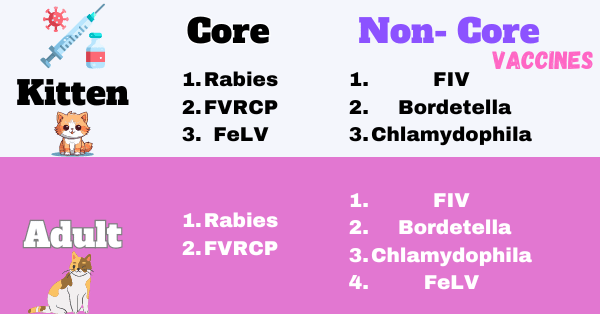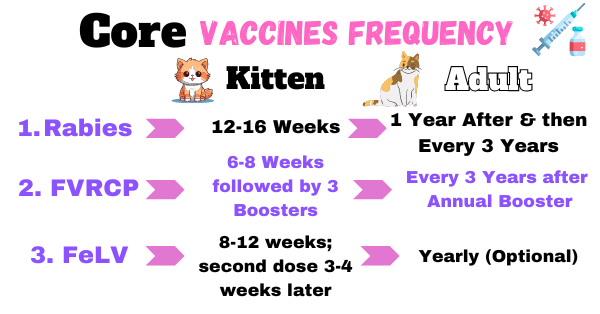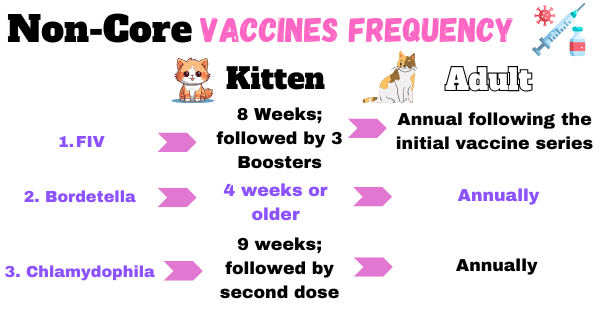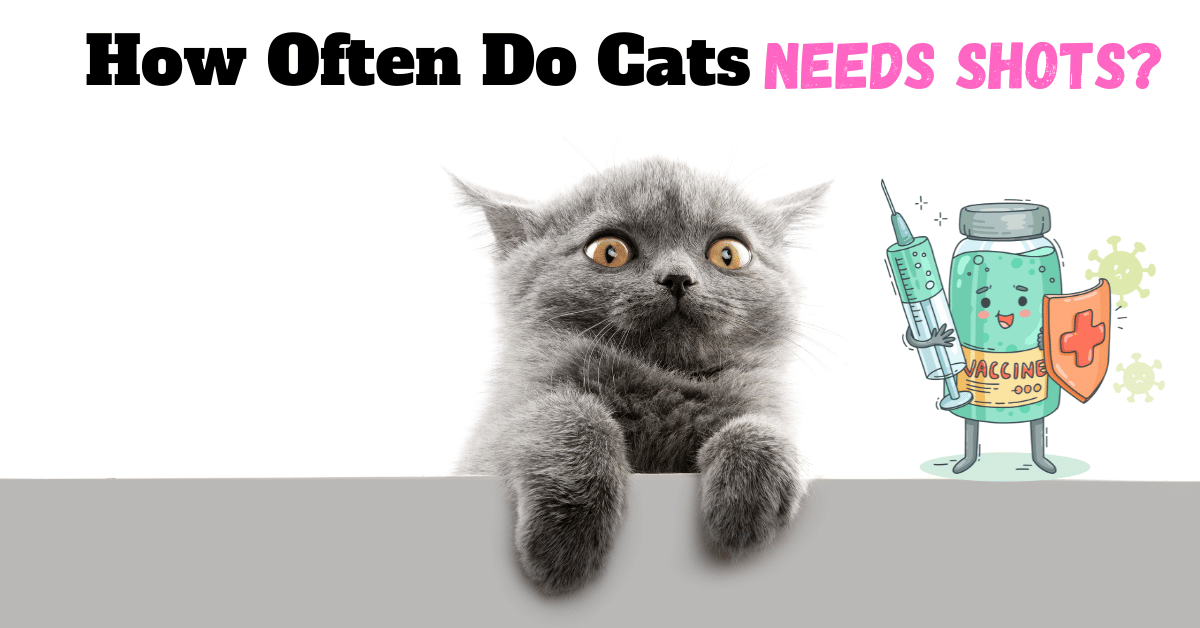This post contains affiliate links and I will be compensated if you make a purchase after clicking on my links.
Understanding Cat Vaccinations: Frequency and Necessity
For cat lovers dedicated to the well-being of their furry friends, keeping up with vaccinations is crucial. Like a mini boot camp for their immune system, vaccinations prepare cats to fend off diseases by exposing them to harmless bits of viruses and bacteria.
Vaccinations are vital for preventing disease and strengthening the immune system. Though no vaccine guarantees 100% efficacy, they significantly reduce the risk of disease transmission among cats.
Each cat has unique health needs, with factors like age, lifestyle, and overall health significantly influencing their vaccination schedule. Regular veterinary consultations are crucial to tailor this schedule accurately—whether your cat is a young kitten just starting their vaccination journey, an adult cat maintaining their health defenses, or a senior with specific medical considerations.
Quick Overview: How Often Do Cats Need Shots?
For cats, getting the right start with vaccinations is crucial. Initially, kittens require several rounds of vaccinations to build their immunity. After completing these initial vaccines, they receive a booster a year later to solidify their defense against diseases.
For adult cats, particularly those who lead a low-risk, primarily indoor lifestyle, the American Association of Feline Practitioners recommends a booster every three years for core vaccines. However, the frequency can differ for non-core vaccines, which are administered based on your vet’s assessment and your cat’s exposure risk.

Core and Non-Core Vaccines for Cats
When it comes to protecting your cat from diseases, it’s essential to understand the difference between core and non-core vaccines. These classifications are based on guidelines from the American Association of Feline Practitioners, widely respected in the veterinary field.
Core Vaccines
The FVRCP vaccine, also known as the distemper shot, conveniently bundles three of the four core vaccinations—excluding Rabies—into one injection. This trio shot protects against Feline Viral Rhinotracheitis, Calicivirus, and Panleukopenia. For adult indoor cats, the FVRCP vaccine is typically updated every three years.
However, cats that venture outdoors, as well as kittens and senior cats, might need this crucial protection updated annually, as recommended by your vet.

1. Rabies Vaccination: A Must-Have for Every Cat
Rabies is a deadly virus required by law to be vaccinated against in many countries, including the United States. Transmitted primarily through bites, this zoonotic disease can affect both animals and humans.
Standard rabies vaccinations last up to three years, though some states require annual shots depending on the vaccine type. Keeping your cat vaccinated against rabies not only complies with public safety regulations but also protects both your pet and your community from potential outbreaks.
Name and Frequency of Rabies Vaccine
- Vaccine: Rabies
- Kittens: First dose at 12-16 weeks
- Adults: Second dose 12 months after the first dose, then every 1-3 years depending on local regulations and vaccine type.
2. Feline Calicivirus: Guarding Against Respiratory Infections
Feline Calicivirus (FCV) is highly contagious among cats, causing symptoms like sneezing, nasal discharge, and oral ulcers. In severe cases, it can lead to chronic gingivitis and stomatitis, which are painful for your pet. Regular vaccination helps manage the spread of different strains of this virus, minimizing severe symptoms and improving your cat’s quality of life.
Name and Frequency of Calcivirus Vaccine
- Vaccine: FVRCP Vaccine.
- Kittens: Start at 6-8 weeks; followed by a series of two to three booster shots, administered every three to four weeks, until 16 to 20 weeks old.
- Adults: Every 3 years after the first annual booster.
3. Feline Herpesvirus: Preventing Severe Respiratory Issues
Also known as Feline Viral Rhinotracheitis, this virus is another culprit for respiratory problems in cats. Spread through close contact such as shared food bowls and litter trays, it causes symptoms like sneezing, nasal congestion, and discharge. Vaccination helps reduce the severity of these outbreaks and can protect your cat from long-term health complications.
Name and Frequency of Herpesvirus Vaccine
- Vaccine: FVRCP Vaccine.
- Kittens: Start at 6-8 weeks; followed by a series of three booster shots, administered every three to four weeks, until 16 to 20 weeks old.
- Adults: Every 3 years after the first annual booster.
4. Panleukopenia: Shielding Cats from Feline Distemper
Often referred to as feline distemper, Panleukopenia is a potentially fatal virus that strikes cats with devastating force, causing symptoms like fever, vomiting, and severe diarrhea. This virus is particularly dangerous for kittens, as it depletes their immune cells and leaves them vulnerable to secondary infections. Vaccinating against Panleukopenia is crucial for preventing this life-threatening disease.
Name and Frequency of Panleukopenia Vaccine
- Vaccine: FVRCP Vaccine.
- Kittens: Start at 6-8 weeks; followed by a series of three booster shots, administered every three to four weeks, until 16 to 20 weeks old.
- Adults: Every 3 years after the first annual booster.
5. Feline Leukemia (FeLV): A Shield Against a Lethal Threat
Feline Leukemia Virus is a serious concern for our feline friends, particularly those who enjoy the great outdoors or share their space with other cats. This virus, which spreads through close contact via saliva, feces, urine, and even milk, attacks the cat’s immune system, leaving them vulnerable to a cascade of health issues, including lymphoma and anemia.
Since there’s no cure for FeLV, prevention through vaccination is essential. Kittens are typically vaccinated with two doses spaced three to four weeks apart, followed by a booster one year later. For cats continually at risk, ongoing vaccinations may be necessary to keep their defenses strong. This vaccine is considered core for all cats under one year of age and non-core for those older.
Name and Frequency of FeLV Vaccine
- Vaccine: Feline Leukemia (FeLV) Vaccine.
- Kittens: First dose at 8-12 weeks; second dose 3-4 weeks later
- Adults: Annually for cats at risk (outdoor or multi-cat environments).
Non-Core (Lifestyle) Vaccines

Non-core vaccines, also known as lifestyle vaccines, are recommended based on specific risk factors related to a cat’s environment, activities, and overall exposure risk. These include:
6. Feline Immunodeficiency Virus (FIV): Safeguarding Your Cat’s Health
Similar to FeLV, Feline Immunodeficiency Virus undermines a cat’s immune system, but it often remains hidden with a lengthy latent period before causing more severe health complications like immunosuppression, secondary diseases, or even cancers.
Vaccination against FIV is generally advised for cats that are frequently outdoors where they might encounter infected individuals or engage in territorial fights that can spread the virus. The initial vaccination series can play a critical role in preventing the disease’s progression, protecting your cat from the potential onslaught of related health issues.
Name and Frequency of FIV Vaccine
- Vaccine: FIV Vaccine
- Kittens (Usually not required at this age): Starting at about 8 weeks of age, your kitten should receive three doses of the vaccine. These should be spaced about 2 to 4 weeks apart to ensure optimal protection as they grow.
- Adults: Before starting their vaccinations, it’s recommended that cats undergo an FIV test to ensure they are negative for the virus. The vaccination course consists of three doses, each administered 2 to 4 weeks apart. Additionally, annual vaccinations are recommended for cats at risk.
7. Bordetella: Reducing Risk of Respiratory Infections
Bordetella, a bacteria well-known for causing kennel cough in dogs, can also lead to upper respiratory infections in cats. This is particularly relevant for cats that frequent kennels, catteries, or grooming facilities where close contact with other cats is common. While the Bordetella vaccine may not completely prevent the infection, it significantly mitigates its severity.
Name and Frequency of Bordetella Vaccine
- Vaccine: Bordetella Vaccine
- Kittens: As early as 4 weeks if at high risk
- Adults: Annually, especially for cats in boarding or communal living
8. Chlamydophila felis: Combating Severe Conjunctivitis
Chlamydophila felis is a bacterial pathogen that primarily causes severe conjunctivitis and can lead to more extensive respiratory issues in cats. This infection is particularly concerning in multi-cat environments such as breeding facilities or cat colonies, where it can cause long-term outbreaks.
The infection has also been linked to infertility in queens, further complicating its impact in breeding settings. Due to the organism’s ability to cause persistent infections and the relatively short-lived immunity post-infection, vaccination is highly recommended to prevent the establishment and spread of Chlamydophila felis in populations.
Name and Frequency of Chlamydophila Vaccine
- Vaccine: Chlamydophila felis Vaccine, in some cases, the vaccine for this bacteria is included in the FVRCP (distemper) shot.
- Kittens: Start at 9 weeks with a second dose 3-4 weeks later.
- Adults: Annually for cats in high-risk environments like shelters or breeding facilities.
Fact: Kittens initially receive essential antibodies from their mother’s milk, not vaccinations. Full immunity kicks in about seven to ten days after they complete their initial vaccination series, making early vaccinations crucial for their health.
Keeping Track with Technology: Smart Scheduling and Reminders
Many veterinary clinics offer apps that not only remind you of upcoming shots but also keep a detailed history of past vaccinations and health records. This digital ledger can be invaluable for maintaining a consistent vaccination schedule, especially as your cat transitions through different life stages.
Apps like the Dogcat app allow you to view your cat’s vaccination schedule, upcoming appointments, and medical history all in one place. They can send you notifications for upcoming shots, making it easier to manage your cat’s health needs without cluttering your calendar.
Debunking Vaccination Myths: What Every Cat Owner Should Know
Misinformation about cat vaccinations can lead to hesitation and potentially harmful gaps in your pet’s health protection. Here are some common myths and the truths behind them:
Myth: Vaccinations are always harmful and cause unnecessary side effects
Truth: While vaccinations can have side effects, they are typically mild, like slight fever or lethargy, and far outweigh the risks of severe disease they prevent. The benefits of vaccinations in protecting against life-threatening diseases like rabies and feline distemper are well-documented and crucial for your cat’s health.
Myth: Indoor cats don’t need vaccinations
Truth: Even indoor cats can be exposed to viruses and bacteria. Airborne pathogens can enter through windows or on clothing, and even the most sheltered pets can escape or come into unexpected contact with infected animals. Core vaccinations are essential for all cats, regardless of their indoor status.
Myth: Cats are vaccinated too frequently
Truth: Vaccination schedules are tailored to a cat’s specific needs and risk exposures. Guidelines from veterinary associations are based on extensive research and clinical evidence, ensuring cats are not over-vaccinated but still protected.
Conclusion: How Often Do Cats Need Shots for a Healthy Life
Vaccinating your cat does more than just protect them from diseases; it plays a crucial role in the health of the wider community, preventing the spread of illnesses that could affect other pets and even humans. It’s essential to comply with local and state regulations, particularly for the legally required rabies vaccine. Even indoor cats are not immune to risks, as airborne germs can find their way inside and even the most sheltered cat may unexpectedly venture outdoors.
By staying proactive with vaccinations and keeping in touch with your veterinarian, you can navigate your cat’s health needs effectively, ensuring they stay protected throughout their life.
Whether your feline friend is a playful kitten or a cherished adult, your vet will guide you on the best vaccines and schedule based on your cat’s specific lifestyle and health risks.
Meet Sean, a fintech whiz with a penchant for pet purrs and blockchain buzz. After a decade of fintech feats, Sean’s tech talents leaped from ledger lines to litter lines, driven by a passion for pets and a vision for a more connected pet care community. With three critter companions as co-pilots, Sean launched this blog to share a treasury of pet-friendly tech tips and tales.


